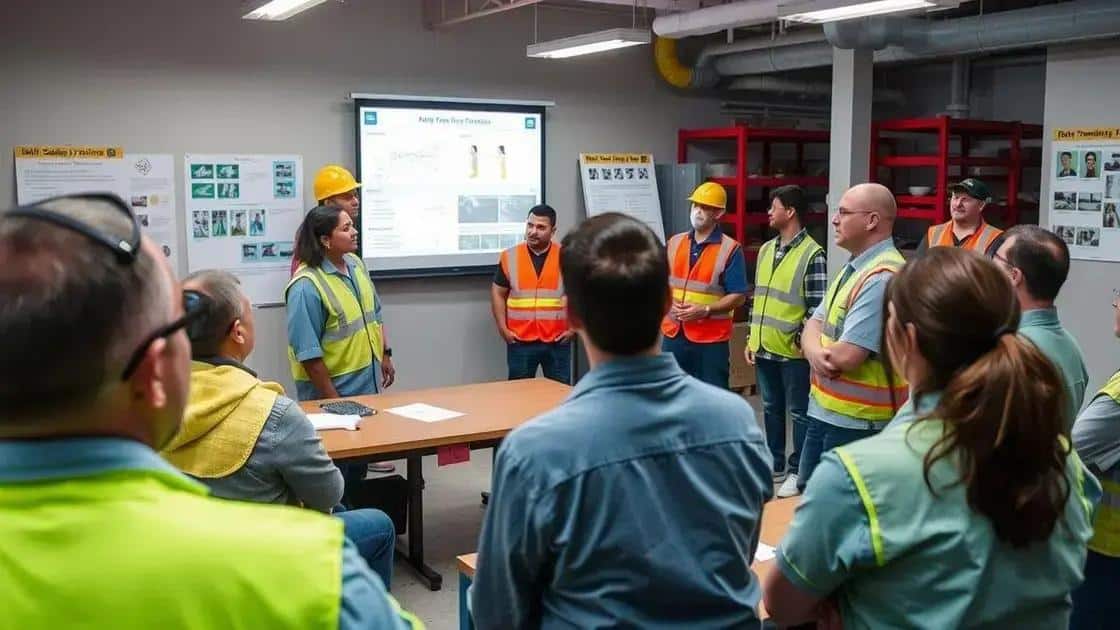Employee public safety announcement: what you need to know

Employee public safety announcements are essential for informing staff about safety protocols, promoting compliance, and fostering a culture of safety in the workplace.
Employee public safety announcement plays a crucial role in maintaining a secure work environment. Have you ever wondered how effective communication can enhance safety? Let’s dive into how these announcements can make a difference.
Understanding the importance of safety announcements
Understanding safety announcements is vital for every workplace. These employee public safety announcements ensure that everyone stays informed and prepared for potential risks or emergencies.
Why are Safety Announcements Important?
Safety announcements help maintain a culture of safety. When employees are regularly updated, they can take necessary precautions. This promotes a sense of responsibility among staff members.
Key Elements of Effective Safety Announcements
- Clarity: Ensure messages are straightforward and easy to understand.
- Frequency: Regular updates help reinforce safety messages.
- Accessibility: Announcements should be visible and reachable for all employees.
In addition to clarity and consistency, incorporating employee feedback can enhance the effectiveness of safety announcements. Engaging staff members in the process can lead to stronger awareness. Safety training sessions are another excellent opportunity to reinforce the information shared in announcements.
Visual aids, such as training materials and infographics, can supplement announcements. They provide a helpful reference that employees can revisit, ensuring they fully grasp essential safety protocols.
Examples of Safety Announcements
Consider different scenarios where safety announcements play an essential role:
- Fire drills: Regularly scheduled announcements prepare employees for what to do in case of an emergency.
- New safety regulations: Keeping employees updated helps them comply with new laws or protocols.
- General reminders: Regular prompts about workplace safety can keep safety at the forefront of employees’ minds.
Continuous learning is crucial. Encourage employees to ask questions or express concerns regarding safety announcements. This fosters an environment where everyone feels accountable for their safety and those around them.
Essential elements of a safety announcement
Creating effective safety announcements requires understanding several essential elements. These elements ensure that the message is communicated clearly and effectively to all employees.
Clarity and Conciseness
Safety announcements should be clear and to the point. Avoid using complex jargon or technical terms that might confuse employees. Simple language helps everyone understand the message quickly.
Relevance to the Audience
It’s crucial that announcements are relevant to the specific group of employees. Tailor the content to address the unique safety concerns of different departments. This personalization increases engagement and compliance.
Frequency of Announcements
Regular safety announcements reinforce the message. Consistent communication ensures that safety remains a priority in the workplace. When employees hear about safety protocols frequently, they are more likely to remember and act on them.
- Share updates during team meetings.
- Utilize emails or digital boards for dissemination.
- Incorporate safety reminders in daily communications.
Visual aids can enhance understanding. Incorporating charts, graphs, or images alongside announcements can help grasp critical information. These visual resources make the information more engaging and easier to remember.
Another key element is the feedback mechanism. Allowing employees to voice their concerns regarding safety protocols helps create an inclusive environment. This feedback loop encourages continuous improvement and adaptation of safety measures.
How to effectively communicate safety protocols

Communicating safety protocols effectively is crucial in any workplace. Clear communication helps ensure that all employees understand their responsibilities regarding safety.
Using Simple Language
When discussing safety protocols, it’s important to use simple language. Avoid jargon and complex terms that might confuse employees. The goal is for everyone to grasp the instructions without difficulty.
Engagement and Interaction
Encouraging interaction can greatly enhance communication. Consider hosting regular safety meetings where employees can ask questions about the protocols. This two-way communication fosters understanding and keeps safety top of mind.
Visual Aids and Resources
Incorporating visual aids is another effective strategy. Using posters, infographics, and videos can make the safety protocols more engaging. Visual tools help reinforce the message and provide a quick reference for employees.
- Post visuals in common areas for easy access.
- Use videos in training sessions to illustrate protocols.
- Create quick reference guides for staff to keep at their desks.
Additionally, frequent repetition of safety information is essential. Regular updates via emails or team discussions can help reinforce the safety culture. Redundancy ensures employees retain the information they need to stay safe.
Lastly, it’s essential to tailor communication methods to suit the workforce. Consider the preferences of different teams. Some may respond better to digital communication, while others may prefer face-to-face interactions. Adapting to these needs can enhance overall safety awareness.
Engaging employees in safety awareness
Engaging employees in safety awareness is crucial for creating a safe workplace. When employees are actively involved, they are more likely to understand and practice safety protocols.
Incorporating Safety Training
One effective method for fostering engagement is through regular safety training sessions. These sessions should be interactive, allowing employees to ask questions and share their experiences. This not only enhances their understanding but also makes them feel valued.
Creating Safety Committees
Establishing safety committees can significantly improve employee involvement. These committees consist of volunteers from different departments who work together to promote safety initiatives. This approach empowers employees to contribute ideas and solutions, fostering a culture of shared responsibility.
Recognizing Safety Champions
Acknowledging individuals who prioritize safety can motivate others to follow suit. Implementing a ‘Safety Champion’ program can highlight employees who demonstrate exceptional safety practices. Recognition can be as simple as a shout-out in meetings or more formal awards.
- Encourage peer-to-peer recognition for safety efforts.
- Highlight safety champions in company newsletters.
- Provide incentives for teams that maintain high safety standards.
Regularly communicating safety updates keeps awareness high. Using newsletters, emails, or bulletin boards to share new safety guidelines helps ensure all employees stay informed. Frequent reminders can reinforce the importance of safety protocols.
Furthermore, encouraging open discussions about safety concerns creates a culture of transparency. Employees should feel comfortable reporting potential hazards without fear of retribution. This open line of communication promotes trust and responsibility among team members.
Evaluating the impact of safety announcements
Evaluating the impact of safety announcements is essential for understanding their effectiveness in the workplace. By assessing how well these announcements are received, organizations can adapt and improve their safety communication strategies.
Measuring Engagement
One way to evaluate impact is by measuring employee engagement with the announcements. Conducting surveys and feedback sessions allows employees to share their thoughts on the clarity and relevance of the information. Engaging employees in this evaluation process empowers them and provides valuable insights.
Monitoring Compliance
Monitoring compliance with safety protocols can indicate the effectiveness of announcements. If employees follow safety guidelines consistently, it shows that the messages are getting through. Tracking incidents and near misses can also help identify areas needing improvement.
Gathering Feedback
Feedback is a two-way street. Encourage employees to discuss safety protocols and share what they find confusing or unclear. This discussion can occur during meetings or through anonymous suggestion boxes. Gathering feedback creates an open environment where employees feel safe expressing concerns.
- Hold regular follow-up meetings to assess safety measures.
- Use feedback forms to capture employee opinions.
- Encourage open dialogue about safety practices.
Moreover, analyzing communication channels can provide insights into how announcements are accessed. Determine which mediums are most effective, whether it’s email, bulletin boards, or digital screens. Understanding these preferences helps target communication better.
Finally, utilizing metrics such as retention of safety information is critical. Assess whether employees can recall safety protocols after announcements. Conduct quizzes or informal assessments to gauge retention levels.
FAQ – Frequently Asked Questions about Employee Public Safety Announcements
Why are safety announcements important?
Safety announcements are crucial because they keep employees informed about protocols, reducing risks and fostering a safer workplace.
How can employees engage in safety awareness?
Employees can engage by participating in safety training, providing feedback, and discussing safety concerns with their peers.
What should safety announcements include?
They should include clear instructions, relevant updates, and visual aids to ensure all employees understand the protocols.
How can I evaluate the effectiveness of safety announcements?
Evaluate effectiveness by gathering employee feedback, monitoring compliance, and analyzing retention of safety information.





